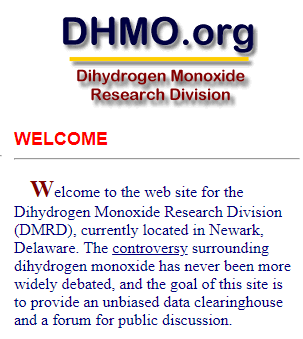A Look at Fake Websites and How To Recognize Them
Did you know that the internet is full of fake stuff? Surprising, right?
As teachers, this is an important aspect of teaching Digital Citizenship, especially in a world that is so connected and digitized.
You would expect that with the world’s knowledge accessible at our fingertips we would be able to sniff out any falsehoods. The unfortunate truth is that people are very believing when reading things online, and may not question if it is true.
I have experienced this when learning about Digital Citizenship. As a fun competition, we were to use certain sites to find the answers to the questions.
Guess what? They were FAKE!
Sites such as dhmo.org, molossia.org, and city-mankato.us were all fake sites.

For example, dhmo.org was advocating against Dihydrogen Monoxide. Do you know what that is? It’s water! That was the first clue that the site was fake. The next clue was that the site looked like something from the 1990s. It was not a polished, professional site that is commonly found today. Overall, the site looked quite sketchy.
Molossia.org was another example. This was a site about a small country in the middle of Nevada. Of course, there is no such place, and this is another fake site. Again, the site had an old format, and the information was highly questionable. For example, in their “language”, “kulturo” means culture. This is completely made up!
Finally, the site about Mankato, Minnesota may seem legitimate at first… Until you realize that the images of a tropical beach in Minnesota aren’t possible! There are also a few tourist attractions, such as the submarine docks, and deep sea fishing in a river. Again, this site looks like it was made in the 1990s.
Implications for Teachers
What do any of these sites have to do with education?
As teachers in this digital age, it is crucial that we teach students about sites like these. If they do not know to question the information they are reading, they will likely believe the information presented to them. In a rushed situation, it is very easy to accept what you are reading.
Digital Citizenship is an important topic to discuss with students of any age when working with technology.
These false sites can be used teach students what to look for when looking for credible sites and information. First, allow them to play around and see if they can discover the falsehoods. Then tell them they were fake sites, and ask for the evidence that they are fake. This learning opportunity is successful because it gives them a safe area to learn from their mistakes. There are fewer consequences than if they clicked on an ad and were unintentionally scammed or found a virus.
Final Thoughts
The more students are aware of their digital interactions, the safer they will be. Showing them how easy it is to be duped makes them warier when finding their own sources for school projects. Constant vigilance is crucial for navigating the internet with students.

Hey man! Great post but I really wanted to just drop a comment on your blog. Your blog has a super cool design. Is this wordpress by chance?
LikeLike
Hey Brian,
Yes, this is WordPress. If you’re looking to start your own I recommend it because it is super easy to navigate.
Thanks for checking out my blog,
Jordan
LikeLike